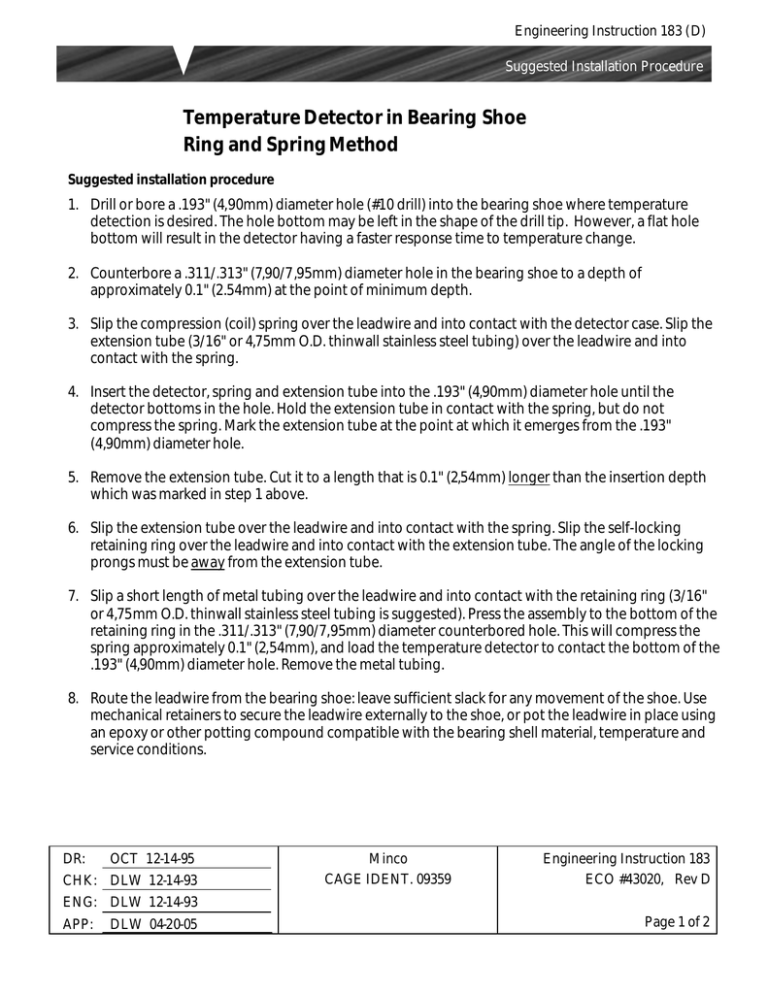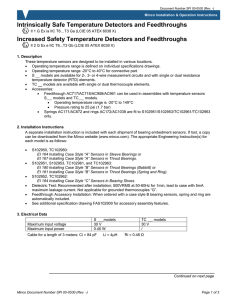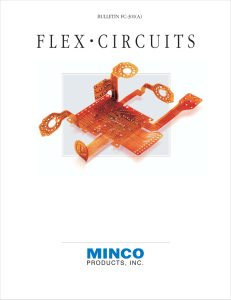Temperature Detector in Bearing Shoe Ring and Spring Method
advertisement

Engineering Instruction 183 (D) Suggested Installation Procedure Temperature Detector in Bearing Shoe Ring and Spring Method, AS5165 Suggested installation procedure 1. Drill or bore a .193" (4,90mm) diameter hole (#10 drill) into the bearing shoe where temperature detection is desired. The hole bottom may be left in the shape of the drill tip. However, a flat hole bottom will result in the detector having a faster response time to temperature change. 2. Counterbore a .311/.313" (7,90/7,95mm) diameter hole in the bearing shoe to a depth of approximately 0.1" (2.54mm) at the point of minimum depth. 3. Slip the compression (coil) spring over the leadwire and into contact with the detector case. Slip the extension tube (3/16" or 4,75mm O.D. thinwall stainless steel tubing) over the leadwire and into contact with the spring. 4. Insert the detector, spring and extension tube into the .193" (4,90mm) diameter hole until the detector bottoms in the hole. Hold the extension tube in contact with the spring, but do not compress the spring. Mark the extension tube at the point at which it emerges from the .193" (4,90mm) diameter hole. 5. Remove the extension tube. Cut it to a length that is 0.1" (2,54mm) longer than the insertion depth which was marked in step 1 above. 6. Slip the extension tube over the leadwire and into contact with the spring. Slip the self-locking retaining ring over the leadwire and into contact with the extension tube. The angle of the locking prongs must be away from the extension tube. 7. Slip a short length of metal tubing over the leadwire and into contact with the retaining ring (3/16" or 4,75mm O.D. thinwall stainless steel tubing is suggested). Press the assembly to the bottom of the retaining ring in the .311/.313" (7,90/7,95mm) diameter counterbored hole. This will compress the spring approximately 0.1" (2,54mm), and load the temperature detector to contact the bottom of the .193" (4,90mm) diameter hole. Remove the metal tubing. 8. Route the leadwire from the bearing shoe: leave sufficient slack for any movement of the shoe. Use mechanical retainers to secure the leadwire externally to the shoe, or pot the leadwire in place using an epoxy or other potting compound compatible with the bearing shell material, temperature and service conditions. DR: OCT 12-14-95 CHK: DLW 12-14-93 Minco CAGE IDENT. 09359 Engineering Instruction 183 ECO #43020, Rev D ENG: DLW 12-14-93 APP: DLW 04-20-05 Page 1 of 2 Minco EI 183 (D) Page 2 of 2 NOTE: Although the illustration below depicts a sleeve bearing shoe, the above installation procedure can be used with other types of bearings, and with equipment other than bearings. Minco (Main Office) 7300 Commerce Lane Minneapolis, MN 55432 USA Tel: 1.763.571.3121 Fax: 1.763.571.0927 Customer Service/ Order Desk: Tel: 1.763.571.3123 Fax: 1.763.571.0942 custserv@minco.com www.minco.com Minco S.A. Usine et Service Commercial, Z.I. 09310 Aston, France Tel: (33) 5 61 03 24 01 Fax: (33) 5 61 03 24 09 Minco EC Hirzenstrasse 2 CH-9244 Niederuzwil Switzerland Tel: (41) 71 952 79 89 Fax: (41) 71 952 79 90 ISO 9001: 2000 EI 183 (D) © Minco 04-200 5 www.minco.com





